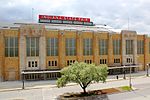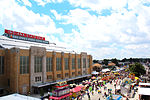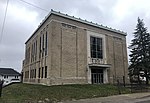1963 Indiana State Fairgrounds Coliseum gas explosion
The Indiana State Fairgrounds Coliseum gas explosion took place in Indianapolis, Indiana, United States, on October 31, 1963; 81 people died and about 400 others were injured. It was one of the worst disasters in the history of the state. On the night of October 31, over 4,000 people were in the Indiana State Fairgrounds Coliseum to watch a Holiday on Ice performance. While this was happening, liquefied petroleum gas was leaking from a tank that was stored with several others in a supply room underneath a part of the grandstands. Shortly after 11 p.m. ET, the gas came into contact with an electrical heating element from the concessions area, causing a major explosion that killed many seated above the room and caused significant damage to the stands. After the initial blast, while people were evacuating, a second blast caused by the remaining, unexploded tanks caused further destruction. Firefighters and other emergency responders were at the site within minutes and survivors were transported via ambulance to various hospitals in the area. The gas tanks were discovered by firefighters during cleanup operations and later testing revealed that they were the cause of the explosion. Following the disaster, a grand jury indicted seven people in total, including employees of the gas provider and the company that operated the arena, as well as the state fire marshal and the city fire chief. However, at later dates all of the individuals either had their charges dropped or their convictions overturned. Victims of the explosion were eventually awarded $4.6 million in settlements. Several city and state agencies investigated the explosion, and it was one of the first events studied by the Disaster Research Center, a research group organized earlier that year to study large-scale disasters. The arena reopened about six weeks after the incident and still stands on the Indiana State Fairgrounds.
Excerpt from the Wikipedia article 1963 Indiana State Fairgrounds Coliseum gas explosion (License: CC BY-SA 3.0, Authors).1963 Indiana State Fairgrounds Coliseum gas explosion
Coliseum Avenue, Indianapolis
Geographical coordinates (GPS) Address Nearby Places Show on map
Geographical coordinates (GPS)
| Latitude | Longitude |
|---|---|
| N 39.8275 ° | E -86.135 ° |
Address
Indiana State Fair Coliseum
Coliseum Avenue
46205 Indianapolis
Indiana, United States
Open on Google Maps







